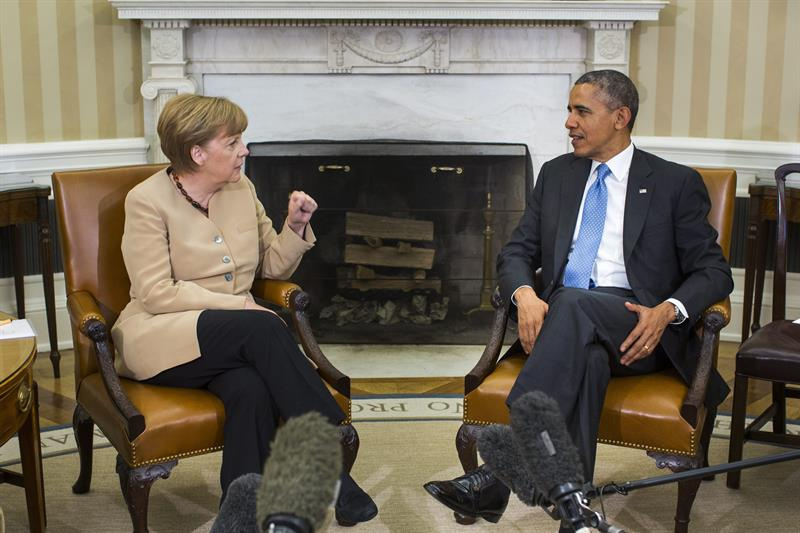Like this article? Chip in to keep stories likes these coming.
On February 9, following a meeting with German Chancellor Angela Merkel, U.S. President Obama announced he is considering shipping arms to Ukraine. Merkel is on a world diplomatic mission explaining that the Russian role in promoting civil war in Ukraine cannot be ended by military means.
A joint press conference revealed that the U.S. still thought it could increase the pressure on Russia by supplying arms to Ukraine, while Merkel wants more efforts to be made to engage diplomatically with Russia.
What lies behind the American willingness to engage in military escalation is a long-standing aim of the American foreign policy establishment to see the installation of a pro-American business regime in Moscow. This was supposed to be the outcome when the Soviet Union collapsed following the fall of the Berlin Wall.
The American political class understood they had “won the Cold War,” and expected to reap benefits. Instead the U.S. attempt to convert Russia to American capitalism failed. As explained in a widely circulated article from Institutional Investor, the best and the brightest from Harvard lost Russia.
Current U.S. efforts focus on the destruction of Vladimir Putin and his regime. It will not be easy to overthrow the tyrant. As the Financial Times has pointed out, Russia under Putin is not so much failing as a democratic state as it is succeeding as an authoritarian state.
Incredibly, the U.S. through a series of moves designed to increase “pressure” on Putin over its backing of separatist forces in eastern Ukraine has committed a blunder of the first order. Obama and his team pushed Russia into recreating a close relationship with China. For decades it has been a goal of U.S. foreign policy to keep the two former communist allies apart. The “rapprochement” upset another major U.S. foreign policy goal: the much vaunted “pivot” to Asia.
By signing a $400-billion energy agreement with China, Russia executed its own Asian pivot that left its traditional European energy clients asking questions about what was being gained by pushing Putin.
Despite the failure of economic sanctions to intimidate Putin and force Russia to withdraw from its strategic objectives of securing additional territorial gains at the expense of Ukraine, the U.S. has not changed course. Supplying the Ukrainian regime it helped to put in place with lethal so-called “defensive” weapons would simply be another step in a process that began when the U.S. under President Clinton antagonized Putin by expanding NATO to former Warsaw Pact countries.
The U.S. does not manufacture much anymore, but it certainly makes arms and military-related equipment. The Obama administration is already sending non-weapon battlefield supplies to Ukraine.
In his recent annual national security report to Congress, Obama talks about the global security agenda. By global security, the U.S. does not mean working with other nations to create the conditions for peace and de-escalation of violence around the world. In the eyes of the U.S., global security means security to pursue U.S. interests around the world.
The president’s statement presented his two big regional trade deals, the Transatlantic Trade and Investment Partnership (TTIP), and the Trans-Pacific Partnership (TPP), as examples of how American leadership creates growth and prosperity. Neither accord process looks likely to succeed. European nations and Pacific nations have questions about being “NAFTA-ized,” with their laws made subject to U.S. corporate lawsuits, as has happened to Canada and Mexico.
From a U.S. foreign policy perspective, the European deal is designed to isolate Russia further, and the Pacific Accord to do the same to China. The American pivot to Asia calls for a redeployment or “rebalancing” of American military forces to Asia.
The U.S. spends more on defence than all other countries put together. The late Chalmers Johnson estimated U.S. overall military spending surpassed $1 trillion for the first time in 2008.
The Congressional Budget Office estimates the U.S. will spend $355 billion over the next 10 years simply on renewing its nuclear arsenal.
Though it went virtually unnoticed, the Ukrainian economy underwent a severe setback in recent days. Its currency lost 50 per cent of its value. The Ukrainian foreign exchange reserves are severely depleted, measuring some $6 billion (compared to Russian reserves of over $350 billion).
There is every reason to believe that Ukraine now faces famine conditions. Yet, instead of receiving a massive aid package, it is being subjected to vicious IMF and EU austerity policies of the type that failed Greece so badly.
In his security report Obama stated, “there are no global problems that can be solved without the United States.” For sure there are no problems the U.S. cannot make worse.
Ukraine is being treated by the U.S. as a pawn in a battle to supplant Putin. The Ukrainian people are going to suffer greatly, and needlessly. The pivot the U.S. (and the EU) needs to make is away from out-of-control military spending, and towards economic and humanitarian assistance on a massive scale, beginning with Ukraine.
Duncan Cameron is the president of rabble.ca and writes a weekly column on politics and current affairs.
Photo: Globovisión/flickr
Like this article? Chip in to keep stories likes these coming.



